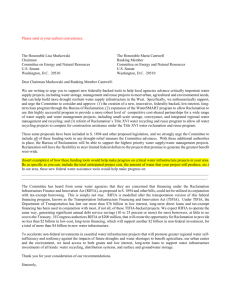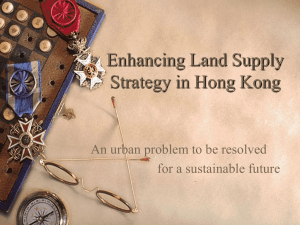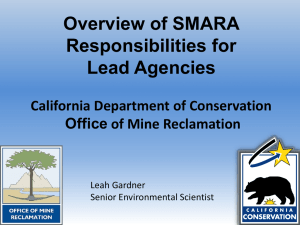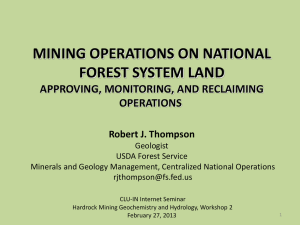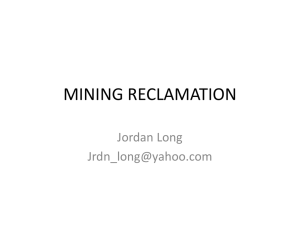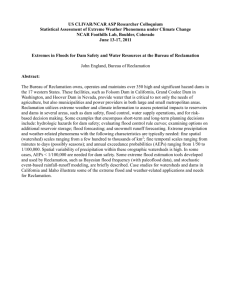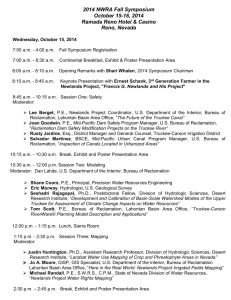EVALUATING COASTAL RECLAMATION IMPACTS
advertisement
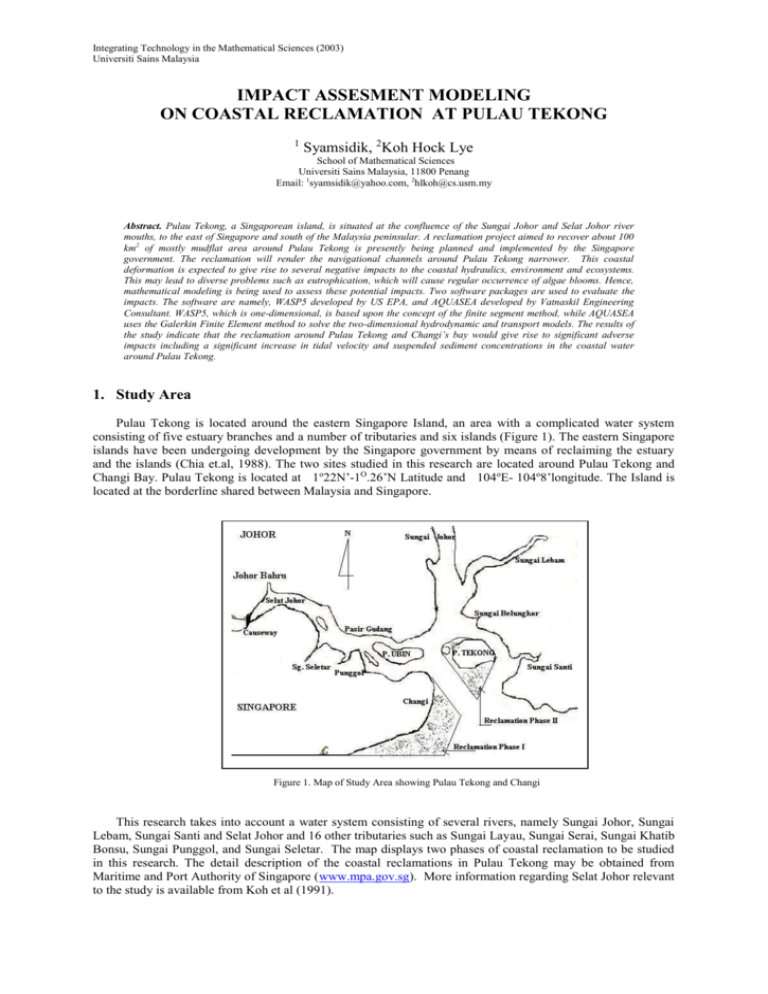
Integrating Technology in the Mathematical Sciences (2003) Universiti Sains Malaysia IMPACT ASSESMENT MODELING ON COASTAL RECLAMATION AT PULAU TEKONG 1 Syamsidik, 2Koh Hock Lye School of Mathematical Sciences Universiti Sains Malaysia, 11800 Penang Email: 1syamsidik@yahoo.com, 2hlkoh@cs.usm.my Abstract. Pulau Tekong, a Singaporean island, is situated at the confluence of the Sungai Johor and Selat Johor river mouths, to the east of Singapore and south of the Malaysia peninsular. A reclamation project aimed to recover about 100 km2 of mostly mudflat area around Pulau Tekong is presently being planned and implemented by the Singapore government. The reclamation will render the navigational channels around Pulau Tekong narrower. This coastal deformation is expected to give rise to several negative impacts to the coastal hydraulics, environment and ecosystems. This may lead to diverse problems such as eutrophication, which will cause regular occurrence of algae blooms. Hence, mathematical modeling is being used to assess these potential impacts. Two software packages are used to evaluate the impacts. The software are namely, WASP5 developed by US EPA, and AQUASEA developed by Vatnaskil Engineering Consultant. WASP5, which is one-dimensional, is based upon the concept of the finite segment method, while AQUASEA uses the Galerkin Finite Element method to solve the two-dimensional hydrodynamic and transport models. The results of the study indicate that the reclamation around Pulau Tekong and Changi’s bay would give rise to significant adverse impacts including a significant increase in tidal velocity and suspended sediment concentrations in the coastal water around Pulau Tekong. 1. Study Area Pulau Tekong is located around the eastern Singapore Island, an area with a complicated water system consisting of five estuary branches and a number of tributaries and six islands (Figure 1). The eastern Singapore islands have been undergoing development by the Singapore government by means of reclaiming the estuary and the islands (Chia et.al, 1988). The two sites studied in this research are located around Pulau Tekong and Changi Bay. Pulau Tekong is located at 1 o22N’-1O.26’N Latitude and 104oE- 104o8’longitude. The Island is located at the borderline shared between Malaysia and Singapore. Figure 1. Map of Study Area showing Pulau Tekong and Changi This research takes into account a water system consisting of several rivers, namely Sungai Johor, Sungai Lebam, Sungai Santi and Selat Johor and 16 other tributaries such as Sungai Layau, Sungai Serai, Sungai Khatib Bonsu, Sungai Punggol, and Sungai Seletar. The map displays two phases of coastal reclamation to be studied in this research. The detail description of the coastal reclamations in Pulau Tekong may be obtained from Maritime and Port Authority of Singapore (www.mpa.gov.sg). More information regarding Selat Johor relevant to the study is available from Koh et al (1991). Integrating Technology in the Mathematical Sciences (2003) Universiti Sains Malaysia The reclamation projects are divided into two phases. The first phase of the reclamation covers Changi’s bay, and will involve 198.106 m3 of landfill. The second phase covers 176.106 m3 of landfill that reclaims Pulau Tekong’s entire mudflat and the adjoining Pulau Tekong Kechik to becomes one island. 2. Scope of the Study Two software are used to assess the possible impacts generated by these reclamation projects, namely Water Quality Analysis Simulation Program (WASP5) and AQUASEA. WASP5 is a software developed by US Environmental Protection Agency (US EPA). WASP5 consists of three sub-programs, namely DYNHYD5 for hydrodynamic simulation, EUTRO5 for eutrophication simulation, and TOXI5 for toxicant simulation. WASP5 uses the finite segment/finite difference method, and is widely used by ecologists to simulate environmental conditions. Meanwhile, AQUASEA is developed by Vatnaskil Engineering Consultant and consists of two major parts. The first part is meant for simulating hydrodynamic regimes, and the second part is for transport modeling. AQUASEA is based on the Galerkin Finite Element Method. By means of these software, potential impacts due to the reclamations are studied subject to three scenarios. Firstly, the existing condition found before reclamation is simulated and this is known as Before Reclamation Model. Secondly, the impacts found after reclamation phase I to be completed at Changi’s Bay is named as Reclamation I model. Lastly, impacts after reclamation phase II, which will include reclaiming Pulau Tekong mudflat area, is referred to as the Reclamation II model. 3. Hydrodynamic Simulation To simulate hydrodynamic regimes subject to tides, both soft wares are used. The amplitude of the tides is based on the spring semidiurnal tidal condition and is equal to 1.1 meter (Admiralty Chart No. 2585). The tidal period is about 12.42 hours. 3.1 DYNHYD5 Hydrodynamic Model This software uses vertically integrated one-dimensional formulations to simulate hydrodynamic regimes. This software uses momentum conservation and mass conservation (continuity equation) as the two main principles of the model. The equation of continuity is based upon the conservation of volume, and estimates water elevations and volumes. Since the model is one-dimensional, the model assumes that coriolis and other accelerations normal to the direction of flow are negligible (Ambrose, et. al., 1993). The momentum equation used in the software is: U U U a g , a f a w, . t x (1) Here, U is rate of change of velocity with respect to time (m/s2), U U t gravitational acceleration along the axis x is advection (m/s2), a g , is of the channel (m/s2), a f is frictional acceleration (m/s2), x is distance along axis of channel (m), t is time (s), U is velocity along the axis of the channel (m/s), and is longitudinal axis (m). Along the longitudinal axis direction: (2) a g , g sin I , where I is channel slope (dimensionless). For along longitudinal distance: H . a g g , x (3) According to the Manning equation, we have: H 1 / 2 , n x U= R 2/3 (4) where R is hydraulic radius (m), and n is the Manning coefficient (dimensionless). For this research, n is 0.02 (Chow, 1986). Then, af gn 2 U U . R4/3 (5) Integrating Technology in the Mathematical Sciences (2003) Universiti Sains Malaysia And, Cd 2 W Cos , R where Cd is the drag coefficient, assumed to be 0.0026 (dimensionless), direction and the wind direction. a w, 1.165 10 3. (6) = the angle between the channel 3.2 AQUASEA Hydrodynamic Model AQUASEA adopts the principles of Mass and Momentum conservation (Vatnaskil, 1998). The equation of continuity is given below: . (7) x (uH ) y (vH ) t Q Here u is the velocity component in the x-direction (m/s), and v is the velocity component in the y-direction (m/s). Meanwhile, the momentum equations in the x and y direction are given below: u u u g k Q u v g fv (u 2 v 2 )1 / 2 u Wx W (u u o ) , 2 t x y x H H HC v v v g k Q 2 2 1/ 2 u v g fu (u v ) v W y W (v vo ) . t x y y H H HC 2 (8) (9) Here, f is the coriolis parameter and k is the wind stress parameter where f equals to 2 sin and k equals to 1.165.10 3 C d . Further, is the earth rotation which is equal to 7.2722 x 10-5 /s, is latitude, C is Chezy (bottom friction) coefficient (m1/2/s), Wx is wind velocity in x-direction (m/s), Wy is wind velocity in y-direction (m/s), W is Wind speed (m/s), u0 is velocity of injected water in x-direction (m/s), and vo is velocity of injected water in y-direction (m/s). The model assumed that all parameters are vertically integrated. 3.3 Simulation Results: Impacts on Tidal Velocity Hydrodynamic regimes due to tides are further studied at some points chosen along Selat Johor, Sungai Johor and around the reclamation areas. Velocities in both directions are vertically integrated. Each of the chosen observation points is analyzed under three scenarios, that is Before Reclamation, Reclamation I, and Reclamation II. The points are chosen based upon the assumption that these points represent the expected hydraulic impacts due to the reclamation projects. For example, Points 1 to 4, which are located in Selat Johor, represent the conditions in Selat johor, and so forth. The locations of the observation points are given in Figure 2. For points far away from the reclamation sites, e.g. Point 1 until Point 4 and Point 6, there is no significant change of velocity due to the reclamations. During a spring tide with an amplitude of 1.1 m, the maximum velocity at points 1 and 6 before reclamation are 0.10 m/s and 0.23 m/s respectively. The velocities at these points are not altered much by the two reclamation schemes. This is because of two reasons. Firstly, the points are far away from the reclamation sites located at Changi’s Bay and Pulau Tekong. Secondly, the position of Pulau Ubin located at the mouth of Selat Johor effectively shelters the velocity changes that happen around the reclamation sites. Point 5 and 6, representing the tidal conditions in the Sungai Johor, have different condition as compared to points in Selat Johor. Here the coastal seas are not sheltered by islands, but receive river inflows from two major rivers, which are known as Sungai Johor and Sungai Lebum. After reclamation, the channel between the Pulau Tekong and Changi's Bay will become narrower. This condition would lead to a bottle-neck condition that hinders current flow during ebb and flood tide. This will lead to changes in tidal velocity. The maximum velocity at points 8 and 9 before reclamation are 0.52 m/s and 0.27 m/s respectively. However, after reclamation II, they are increased to 0.79 m/s and 0.33 m/s respectively. Since the influences are closely related to the distance, these impacts are found to be less significant at Point 6 as compared to Point 5, since Point 6 is located farther away from the reclamation sites than Point 5. The percentage change in tidal velocity at the 10 observation points due to the reclamations are tabulated in Table 1. Table 1 shows that the impacts are significant at Points 8, 9, and 10 with the percentage change of more than 20 %. The maximum vertically averaged velocity found in the channels after the Reclamation II is 0.79 m/s at Point 8. The impacts of the reclamation to the velocity can be considered high since the velocity change at some points exceeds 50 %, as compared to the condition before Reclamation Project. This will bring about Integrating Technology in the Mathematical Sciences (2003) Universiti Sains Malaysia some concerns regarding environmental water quality, as well as safety to navigation for ships. It should be noted that the computed velocity at Point 8 of 0.79 m/s is vertically averaged, which translates to a velocity that exceeds 1.0 m/s at the surface. This magnitude of velocity may post hazards to safe navigation of ships in the narrow channels around Pulau Tekong and may also erode the nearby coastal land, leading to erosion at some place and siltation at others. Figure 2. Locations of 10 Observation Points Table 1 Percentage of Velocity Changes Due to the Reclamation Projects Point 1 2 3 4 5 6 7 8 9 10 % Velocity Changes Due to Reclamation I Flood Tide Ebb Tide 4.8 -1.0 4.0 -2.0 3.4 -2.3 7.0 -1.7 -6.1 -13.9 1.8 -2.9 -11.3 -13.3 49.7 45.7 56.7 56.6 23.0 18.6 % Velocity Changes Due to Reclamation II Flood Tide Ebb Tide 5.1 -3.5 8.5 -4.5 8.5 -3.9 9.6 -5.1 -13.3 -25.4 7.9 -5.1 -2.2 -8.1 50.1 38.9 22.5 20.0 31.8 21.8 Note: (-) negative sign means the velocity is lower than Before Reclamation Model 4. BOD-DO Simulation After ignoring factor of respiration, photosynthesis, and sediment oxygen demand, BOD-DO relation can be summarized in the following equation, which is often known as the Streeter-Phelps Equation (Thomann and Mueller, 1987). V dDi 0 Qi 1,i Di 1 Qi ,i 1 Di E 'i 1,i ( Di 1 Di ) E 'i ,i 1 ( Di 1 Di ) K ai Di WDi K diVi Li dt i= 1,2,3…,n . (10) Here Kai is the reaeration rate at segment i (s-1), Kdi is deoxygenation rate at segment i(s-1) , Di is dissolved oxygen deficit at segment i( kg/m3), E’i-1,i is bulk dispersion coefficient between segment i-1 and i (m3/s), Li is BOD concentration at segment i (kg/m3), and WDi is the loading at segment i(kg/s). Deoxygenation rate and reaeration rate are chosen from a range of values given in the literatures by applying the appropriate Integrating Technology in the Mathematical Sciences (2003) Universiti Sains Malaysia formulation. Deoxygenation rate (Kd) is assumed to be 0.3/day, which is in the range 0.1/day to 0.3/day as given by Bowie et.al (1985). This value has been used in previous studies in the region. Meanwhile, two reaeration rates (Ka) are assumed, that is 0.5/day and 0.1/day, after careful consideration of many factors. The first value of 0.5/day is adopted to account for reaeration in the top 3 meters of the water column and is in the range of 0.05/day to 12.2/day, as suggested by Thomann and Mueller (1987). A second scenario will be performed with a reduced rate of reaeration of 0.1/day to reflect a deeper water depth of around 10 m. Hence the levels of DO for the first scenario are expected to be higher than those in the second scenario. Temperature is taken at average value of 27oC, and average salinity is equal to 30 ppt. Additional information regarding Johor coastal water within the study site is available from Koh and Lee (2001) and Koh et al (1995). The Streeter-Phelps BOD-DO concept is used to simulate Pulau Tekong’s BOD-DO Models by dividing the water system into 72 segments as shown in Figure 3. Sg. Johor 35 42 57 Sg. Lebam 42 Kim-Kim Selat Johor 1 19 Causeway Punggol 58 60 27 34 69 PP.Tekong 20 26 70 65 67 Changi 72 Figure 3. Schematic Diagram showing the network of Segment in WASP5. This concept is applied to these models by means of WASP5/EUTRO5. Input to Pulau Tekong’s BOD-DO models are based on multiple point sources since there are several tributaries and loading points located along the model’s channels. BOD sources are generated from various land-based activities such as industrial, municipal and farming activities. These sources flow into the water bodies as pollutant. The loading values are obtained from previous investigations around the area and from official sources such as the Department of Environmental of Malaysia (Murray et.al, 1994). The loading at Pulau Tekong is assumed to have class II water quality with BOD concentration of 3 mg/L and a flow rate of 0.5 m3 /s into segment 71. This assumption is based upon the land utilization in Pulau Tekong that caters mainly for military activities, but not for residential or industrial purposes (Chia.et.al, 1988). This loading rate is adopted for Reclamation I BOD-DO Model. On the other hand, for Reclamation II Model, loading at Pulau Tekong is modified to become 6 mg/L, which has a class III water quality. This assumption is based on the prediction that the population on the island will be doubled after the reclamation II, as compared to Reclamation I. The Pulau Tekong loading’s flow is estimated to be about 0.5 m3/s, which is based on its catchment’s area of 17 km2. The results of simulation for the three model scenarios are displayed in Figure 4. To test the statistical significance of the impact, the Independent Sample T-Test of SPSS Release 9.0 is used. The results of this statistical method show that the reclamation projects will not have any significant impact on the levels of dissolved oxygen DO. (tcalulated = 0.58 < ttable = 1.64). The levels of DO stay above 5.0 mg/l, which is considered healthy for marine lives. The dissolved oxygen at point 9, for example, is 6.81 mg/l before reclamation, but is increased slightly to 6.83 mg/l after reclamation II. The above analysis is valid only if the SS levels generated by the reclamation remain low. However, as will be shown in the next section, SS levels in the vicinity of the reclamation sites would likely increase significantly. These high levels of SS will exert oxygen demand on the water hence reducing the DO. This sediment BOD, which is not being considered in the present model, will be the focus of a future paper. The simulation results for the case of reaeration rate of 0.1/day are presented in Figure 5. The differences are significant at some locations. Around the Causeway the DO levels now have dropped to below 3.0 mg/l, which is not healthy for most marine lives, in particular fish. This reduced DO near the Causeway is not a consequence of the reclamation in Tekong, but rather reflects the environmental conditions near the Causeway. A depth-averaged model would not distinguish the distribution over the depth of the water column. Hence a Integrating Technology in the Mathematical Sciences (2003) Universiti Sains Malaysia proper integration and interpretation of the two simulation results should be considered. Hence, for example, the DO levels near the seabed around the Causeway may be near anaerobic since the depth-averaged DO there is below 3 mg/l but exceeds 5.0 mg/l near the top of the water. Dissolved Oxygen Bio Oxygen Demand 7.00 1.50 6.80 1.25 6.60 Concentration (mg/L) Concentration (mg/L) 6.40 6.20 6.00 5.80 5.60 1.00 0.75 0.50 5.40 0.25 5.20 5.00 0.00 0 6 12 18 24 30 36 42 48 54 60 66 72 0 6 12 18 24 Segment 30 36 42 48 54 60 66 72 Segment Before Reclamation Reclamation I Reclamation II Figure 4. Dissolved Oxygen and Bio Oxygen Demand Simulation for Pulau Tekong, Ka=0.5/day Concentration (mg/L) 8.00 7.00 6.00 5.00 4.00 3.00 2.00 1.00 0.00 0 6 12 18 24 30 36 42 48 54 60 66 72 Segment (mg/L) Before Reclamation Reclamation I Reclamation II Figure 5. Distributions of DO with Ka= 0.1/day 5. Suspended Sediment Simulation Suspended sediment (SS) model is simulated by AQUASEA software. In these models, the suspended sediment loadings are assumed to come from the reclamation areas. The first loading is expected at Changi’s reclamation site and the second is at Pulau Tekong Reclamation site. The value of loading is obtained by assuming a spill rate of 1 %, that is 1% of landfill materials will contribute as suspended sediments in the water column, and a landfill material density of 2650 kg/m3. These projects are expected to be completed in 8 years and will consume a total of 374 x106 m3 of landfill materials. Settling velocity is assumed to be 0.0001 m/s as recommended by Vatnaskil Consultant. Meanwhile, the critical shear stress for erosion ( e ) is 0.75 N/m2 and the bottom shear stress ( b ) is predicted to be 0.1 N/m2, and erodibility (erosion rate) equal to 0.2 kg m-2s-1 (Vos. et al, 2000). Integrating Technology in the Mathematical Sciences (2003) Universiti Sains Malaysia The results show that the reclamation will have significant adverse impacts on the suspended sediment (SS) concentrations in the water system, as shown in Figure 4, which indicates a significant increase in SS. The SS concentration at point 8 will be increased by 160 mg/l during reclamation II. At the point 6, being farther away, the increase in SS due to reclamation II is now 15 mg/l. The model results are based upon the assumption that the spill rate is 1 %. The spill rate may be higher if the control measures are not effective or when there is an increase in reclamation pace at certain time. If the spill rate is 5 %, then the SS levels mentioned above will be increased by 5 times. In this event, the SS level at point 8 would become 800 mg/l. This sharp increase in SS levels around the reclamation sites in the coastal seas would have adverse impacts on marine organisms living in the area, which would include sea grass, fish, mussels and corals. It may also cause other adverse impact such as increase rate of sedimentation. (a) (c) (b) (d) Figure 4. Suspended Sediment Concentration (mg/L): (a). Before Reclamation; (b) Reclamation I; (c) Reclamation Model II; (d) Combination of Reclamation I and Reclamation II. 6. Conclusion Based upon the three scenarios studied in this research, it may be concluded that the coastal reclamations at Pulau Tekong and Changi’s Bay will have the potential to generate several negative impacts to the tidal hydrodynamic regimes by significantly increasing tidal velocity around Pulau Tekong and by significantly increasing suspended sediment concentrations in the water column. Increase in tidal velocity would post hazards to safe navigation of ships in the narrow channels, and may also increase rate of erosion. Increased suspended sediment concentrations would have adverse impacts to marine lives and would also increase the rate of siltation in the coastal areas. High SS loads in the water are harmful to most fishes and may smother benthic organisms. Over all, the impacts of reclamation are predicted to be adverse to the environment and the marine ecosystems. Integrating Technology in the Mathematical Sciences (2003) Universiti Sains Malaysia 7. Acknowledgements We would like to thank the Department of Environment of Malaysia, and the Department of Irrigation and Drainage of Malaysia for contributing valuable data for this research. The Japan Bank of International Coorperation, JBIC funded the first author for his MSC dissertation. Such contribution is highly appreciated. References Ambrose, R.B., Wool, T.A., and Martin, J.L. 1993. The Water Quality Analysis Simulation Program, WASP5, Environmental Research Laboratory, Athens-Georgia Bowie. G.L., Mills, W.B., Porcella, D.B., Campbell, C.L., Pagenkopf, J.R. Rupp, G.L., Johnson, K.M., Chan, P.W.H., Gherini, S.A., and Chamberlin, C.E. 1985. Rates, Constant and Kinetics Formulation in Surface Water Quality Modeling, 2nd Edition, US EPA, Georgia. Chia, L.S, Khan, H., and Ming, C. L. 1988. The Coastal Environmental Profile of Singapore, ICLARM, Manila-Philippines. Chow, V.T. 1986. Open Channel Hydraulics, International Edition, McGraw-Hill, Singapore. Koh, H.L. and Lee, H.L. 2001. Modeling Water Quality in Sg. Lebum, Johor, Malaysia. In: Recent Advances in Marine Science and Technology, 2000. Ed. Narendra Saxena, p.199-208. PACON International, USA, June 2001. Koh, H.L., Lim, P.E. and Lee, H.L. 1995. Water Quality Modeling for An Estuary in Johore. Water Qual. Res. J. Canada 30(1):45-52. Koh, H.L., Lim, P.E. and Midun, Z. 1991. Management and Control of Pollution in Inner Johore Strait. Environmental Monitoring and Assessment 19: 349-359, Netherlands. Murray-North (SEA) Pte. Ltd., Scott & Furphy Pte.Ltd., Lawson and Treloar Pte. Ltd., Europasia Engineering Services Sdn. Bhd., Asian Wetlands Bureau Malaysia and University of Malaysia. 1994. Hydraulic and Water Quality Study of the Strait of Johor, Final Report, Ministry of the Environment, Republic of Singapore and Ministry of Science, Technology and Environment of Malaysia. Thomann, R.V., and Mueller, J.A. 1987. Principles of Surface Water Quality Modeling and Control, HarperCollins Publishers Inc., New York-USA. Vatnaskil Engineering Consultant. 1993. AQUASEA Tidal flow in Estuaries and Coastal Areas Lake Circulation Transport Modelling, Iceland. Vos, R.J., Brummelhuis, P.G.J., and Gerritsen, H. 2000. Integrated-Data Modeling Approach for Suspended Sediment Transport on a regional scale, Coastal Engineering 41(2000) 177-200.

